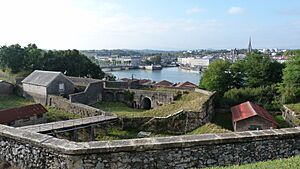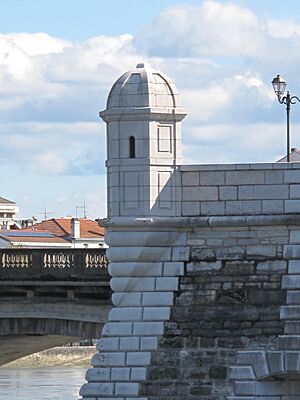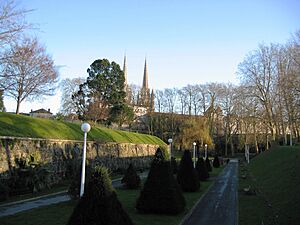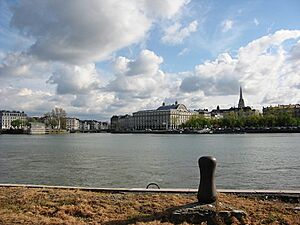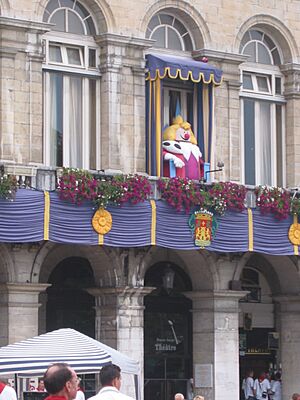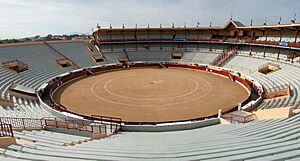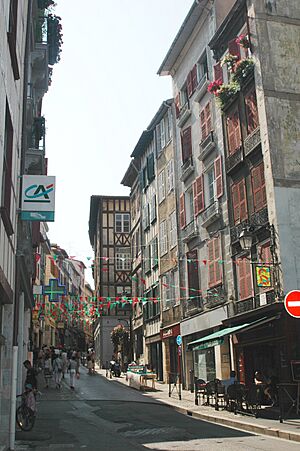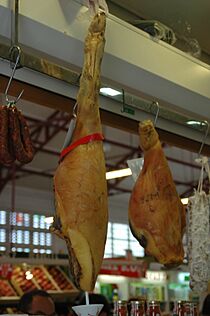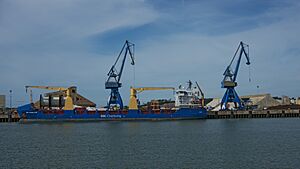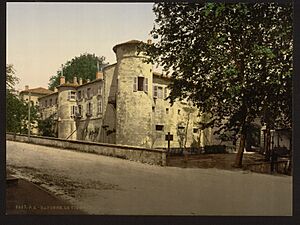Bayonne facts for kids
Quick facts for kids
Bayonne
Baiona (Basque)
|
|||
|---|---|---|---|
|
Subprefecture and commune
|
|||

View of the historic centre
|
|||
|
|||
| Country | France | ||
| Region | Nouvelle-Aquitaine | ||
| Department | Pyrénées-Atlantiques | ||
| Arrondissement | Bayonne | ||
| Canton | Bayonne-1, 2 and 3 | ||
| Intercommunality | CA Pays Basque | ||
| Area
1
|
21.68 km2 (8.37 sq mi) | ||
| Population
(2021)
|
52,749 | ||
| • Density | 2,433.1/km2 (6,301.6/sq mi) | ||
| Time zone | UTC+01:00 (CET) | ||
| • Summer (DST) | UTC+02:00 (CEST) | ||
| INSEE/Postal code |
64102 /64100
|
||
| Elevation | 0–55 m (0–180 ft) (avg. 4 m or 13 ft) |
||
| 1 French Land Register data, which excludes lakes, ponds, glaciers > 1 km2 (0.386 sq mi or 247 acres) and river estuaries. | |||
Bayonne is a lively city in Southwestern France. It is very close to the Spanish border. Bayonne is a commune, which is like a local town area. It is also one of the main cities in the Pyrénées-Atlantiques area. This area is part of the Nouvelle-Aquitaine region of France.
The city sits where two rivers, the Nive and Adour, meet. This is in the northern part of the Basque Country. Bayonne is the main city of a larger group of towns called the Communauté d'agglomération du Pays Basque. This group includes coastal cities like Biarritz.
Bayonne, along with nearby Anglet and Biarritz, forms a big urban area. In 2018, about 273,000 people lived in this larger area. About 51,000 people lived in Bayonne itself. It is also part of the "Basque Eurocity Bayonne-San Sebastián," which connects cities in France and Spain.
People probably lived in Bayonne even before ancient times. A strong fort was built here in the 1st century. This was when the Tarbelli people lived in the area. Later, the Romans built a stronghold called a castrum in the late 4th century.
In 1023, Bayonne became the capital of a region called Labourd. In the 12th century, the city grew bigger. The first bridge over the Adour River was built then. In 1152, Bayonne came under English rule. This happened when Eleanor of Aquitaine married Henry II of England. The city became very important for trade by sea.
In 1451, France took control of Bayonne after the Hundred Years' War. The river then became difficult for ships to use. This hurt trade. Later, Jewish refugees from Spain settled in a district called Saint-Esprit. They brought skills like chocolate making. Bayonne became famous for its chocolate.
In 1578, the Adour River was changed to make it easier for ships. Bayonne became busy with sea trade again. In the 17th century, the city was made stronger with new forts by Vauban. These forts were used as models for a long time. In 1814, there was fighting around Bayonne. This was the last time the city was under siege.
In 1951, a gas field was found nearby. Oil and sulfur from it are shipped from Bayonne's port. In the late 1900s, many new homes were built. Bayonne grew into a large city with Anglet and Biarritz. Today, Bayonne is an important economic and cultural center. It has strong Basque and Gascon influences. It is known for its history, architecture, food, and events like the Fêtes de Bayonne.
The people who live in Bayonne are called Bayonnais or Bayonnaises.
Contents
What's in a Name?
The Name Bayonne
The name "Bayonne" has an interesting history. In the local Basque and Gascon languages, it is spelled Baiona.
One idea is that "Bayonne" comes from words meaning "water" or "good river." For example, in Basque, bai means "river" and ona means "good." So, it could mean "good river." Another idea is "the place of the river" or "hill by the river."
For a long time, the names "Labourd" (the region) and "Bayonne" (the city) were used for the same place. But in the 12th century, they became separate. "Labourd" was for the region, and "Bayonne" was for the city.
A Look Back in Time
Early History
People likely lived in Bayonne even before ancient times. This was probably a fishing village. Many signs of early human life have been found nearby. The city grew on a hill next to the Nive River. This hill was a natural defense and a good port. It was surrounded by swamps, but the river narrowing here made it an important crossing point.
Roman Times

In the 1st century AD, the Romans came to Bayonne. They built a wall around the city to protect it. This was to keep out local tribes like the Tarbelli and Aquitani.
Archaeologists found old objects from the 1st to 3rd centuries. This shows that people lived here, not just soldiers. A Roman fort, called a castrum, was built in the late 4th century. It was named Lapurdum, which later became the name of the region, Labourd. This Roman fort was important for watching the roads through the Pyrenees mountains.
The Middle Ages
Bayonne's location made it perfect for a fort and a port. After the Romans left in the 4th century, the Basques took over. The region was called Vasconia, then Gascony.
There is not much information about Bayonne in the early Middle Ages. But we know of two attacks by the Normans in the 9th century.
In 1023, Bayonne became the capital of Labourd. The city's history really began in 1056. That's when a bishop started building the Church of Bayonne.
By 1120, new parts of the city were built because more people moved there. The city's defenses were also improved to protect these new areas.
In 1130, the King of Aragon tried to attack Bayonne but failed. In 1152, Bayonne came under English rule. This gave the city many trade benefits. People from Bayonne carried wine, resin, ham, and other goods to England. Bayonne was also an important military base.
In 1177, the English King Richard the Lion Heart separated Bayonne from Labourd. Labourd's new capital became Ustaritz. In 1215, Bayonne gained its own city rules. This gave it more freedom from feudal lords.
Shipbuilding was a major industry in Bayonne. There was plenty of wood from the Pyrenees and Landes forests. Bayonne also had a strong maritime tradition. Its sailors worked in whaling and merchant shipping. They also served in the English Royal Navy.
Renaissance and Modern Times
In 1451, a French general named Jean de Dunois captured Bayonne. The city became part of France. The French kings continued to strengthen Bayonne's defenses. This was to protect it from Spain.
In 1462, King Louis XI allowed Bayonne to hold two yearly fairs. This helped the city's trade.
During the Spanish Inquisition, many Spanish and Portuguese Jews fled to Southern France. Some settled in Saint-Esprit, a district of Bayonne. They brought their skill in making chocolate. By 1750, about 3,500 Jewish people lived in Saint-Esprit.
The city's golden age ended in the 15th century. Trade with England stopped, and the port became blocked with silt.
In the early 16th century, the plague affected the region. Bayonne tried to stop people from plague-stricken areas from entering. In 1519, the plague was so bad that the city council moved away.
In 1523, French troops defended Bayonne from a Spanish attack. It was at the Château-Vieux that money was collected to free King Francis I, who was captured in battle.
In 1565, an important meeting happened in Bayonne. Catherine de Medici met with a Spanish envoy. At this time, Catholics and Protestants were fighting in France. Bayonne stayed relatively peaceful. City leaders were very strict to keep order.
In the 16th century, engineers changed the Adour River's course. This made the port much better. On October 28, 1578, the river flowed directly to the ocean again. Bayonne's port became very busy with fishing and trade.
In the 17th century, Vauban fortified Bayonne for Louis XIV. He built a citadel on a hill. During this time, a new weapon was invented in Bayonne. Peasants attached long hunting knives to their muskets. These were later called bayonets.
French Revolution and Empire
Bayonne was very active in the 18th century. The Chamber of Commerce was founded in 1726. Trade with Spain, the Netherlands, and the Antilles was strong. Cod fishing off Newfoundland also brought wealth.
In 1792, the Saint-Esprit district was separated from Bayonne. It became its own town and was part of the Landes area. It rejoined Bayonne in 1857.
In 1808, the Spanish king signed an agreement at the Château of Marracq. He gave up his throne to Napoleon. This led to the first Spanish constitution, called the Bayonne Statute.
Trade in Bayonne suffered in the 19th century due to conflicts with Spain. The Siege of Bayonne in 1814 was the last time the city was attacked. Napoleon's troops were defeated by a coalition led by Wellington.
19th and 20th Centuries
In 1854, the railway arrived from Paris. This brought many tourists to the beaches of Biarritz. Bayonne also developed a steel industry. The port became more industrial.
The Treaty of Bayonne was signed in 1856. It settled the border between France and Spain.
Bayonne built three light railway lines to connect to Biarritz. These lines operated from the late 1800s to the mid-1900s.
In 1933, a big financial scandal started in Bayonne. It was called the Stavisky Affair. This event, along with other problems, led to riots in Paris in 1934.
The World Wars
During the First World War, many soldiers from Bayonne fought. About 700 people from Bayonne died in the war. Bayonne was also a place where foreign volunteers joined the army.
During the Second World War, German troops occupied Bayonne from 1940 to 1944. On August 21, 1944, the Germans left after blowing up ships in the port. The city was freed on August 23.
City Life and Government
City Leaders (Mayors)
Bayonne has had many mayors throughout its history. For a long time, from 1472 to 1789, the Gramont family provided the city's leaders. King Henry IV even made the mayor's job hereditary for them in 1590.
Here are some of the mayors of Bayonne:
- Antoine III of Gramont-Touloujon (1604–1678) was a Duke and a Marshal of France. He welcomed King Louis XIV to Bayonne in 1660.
- Antoine Charles IV of Gramont (1641–1720) continued the fortification work by Vauban. He helped supply troops during the War of the Spanish Succession.
Since 1941, mayors have been elected.
- Henri Grenet was mayor from 1959 to 1995.
- Jean Grenet was mayor from 1995 to 2014.
- Jean René Etchegaray has been the mayor since 2014.
City Divisions (Cantons)
Bayonne is divided into areas called cantons. These help with local government. In 2014, new divisions were made. Now, there are three cantons in Bayonne: Bayonne-1, Bayonne-2, and Bayonne-3.
Courts and Services
Bayonne has many courts for the region. It also has a police station and a tax office.
Working Together (Intercommunality)
Bayonne is part of several groups that work together. The most important is the Communauté d'agglomération du Pays Basque. This group includes nearby towns like Anglet and Biarritz. They work on things like economic development, housing, and public transport.
Bayonne is also part of the Basque Bayonne-San Sebastián Eurocity. This group connects cities in France and Spain for economic cooperation.
Sister Cities
Bayonne has "sister city" relationships with many cities around the world. This helps build friendships and cultural exchange.
 Veliko Tarnovo, Bulgaria
Veliko Tarnovo, Bulgaria Satu Mare, Romania
Satu Mare, Romania Pamplona, Spain
Pamplona, Spain Nyíregyháza, Hungary
Nyíregyháza, Hungary L'Hospitalet de Llobregat, Spain
L'Hospitalet de Llobregat, Spain Kajaani, Finland
Kajaani, Finland Hydra, Greece
Hydra, Greece Faro, Portugal
Faro, Portugal Daytona Beach, Florida, United States
Daytona Beach, Florida, United States Bayonne, New Jersey, United States
Bayonne, New Jersey, United States Ascoli Piceno, Italy
Ascoli Piceno, Italy
Bayonne's Location and Climate
Where Bayonne Is
Bayonne is in the southwest of France. It's on the border between the Basque Country and Gascony. The city is built where the Adour and Nive rivers meet. This is about 6 kilometers (4 miles) from the Atlantic Ocean.
 |
Boucau / Bokale | Tarnos | Saint-Martin-de-Seignanx |  |
| Anglet / Angelu | Saint-Barthélemy | |||
| Bassussarry / Basusarri | Villefranque / Milafranga | Lahonce / Lehuntze |
Rivers and Water
The city grew along the Adour River. The Adour is important for nature and is part of the Natura 2000 network. The Nive River joins the Adour in Bayonne. Two smaller streams also flow into the Adour in Bayonne.
Weather in Bayonne
Bayonne has an oceanic climate. This means it's influenced by the Atlantic Ocean. It gets a fair amount of rain. Winters are mild, with average temperatures around 8°C (46°F). Summers are warm, around 20°C (68°F).
The lowest temperature ever recorded was -12.7°C (9.1°F) in 1985. The highest was 40.6°C (105.1°F) in 2003. Rain on the Basque coast usually comes as short, intense thunderstorms, not long, steady rain.
| Town | Sunshine (hours/yr) |
Rain (mm/yr) |
Snow (days/yr) |
Storm (days/yr) |
Fog (days/yr) |
|---|---|---|---|---|---|
| National average | 1,973 | 770 | 14 | 22 | 40 |
| Bayonne | 1920 | 1450 | 2.2 | 35.5 | 28.5 |
| Paris | 1,661 | 637 | 12 | 18 | 10 |
| Nice | 2,724 | 767 | 1 | 29 | 1 |
| Strasbourg | 1,693 | 665 | 29 | 29 | 56 |
| Brest | 1,605 | 1,211 | 7 | 12 | 75 |
| Climate data for Biarritz-Anglet (altitude 69 metres (226 feet), 1981–2010) | |||||||||||||
|---|---|---|---|---|---|---|---|---|---|---|---|---|---|
| Month | Jan | Feb | Mar | Apr | May | Jun | Jul | Aug | Sep | Oct | Nov | Dec | Year |
| Record high °C (°F) | 23.4 (74.1) |
28.9 (84.0) |
29.7 (85.5) |
32.1 (89.8) |
34.8 (94.6) |
39.2 (102.6) |
39.8 (103.6) |
40.6 (105.1) |
37.0 (98.6) |
32.2 (90.0) |
27.8 (82.0) |
25.1 (77.2) |
40.6 (105.1) |
| Mean daily maximum °C (°F) | 12.0 (53.6) |
12.8 (55.0) |
15.0 (59.0) |
16.2 (61.2) |
19.6 (67.3) |
22.1 (71.8) |
24.1 (75.4) |
24.7 (76.5) |
23.2 (73.8) |
20.0 (68.0) |
15.1 (59.2) |
12.5 (54.5) |
18.1 (64.6) |
| Daily mean °C (°F) | 8.4 (47.1) |
8.9 (48.0) |
11.0 (51.8) |
12.4 (54.3) |
15.6 (60.1) |
18.3 (64.9) |
20.4 (68.7) |
20.8 (69.4) |
18.8 (65.8) |
16.0 (60.8) |
11.4 (52.5) |
9.0 (48.2) |
14.3 (57.7) |
| Mean daily minimum °C (°F) | 4.8 (40.6) |
5.0 (41.0) |
7.0 (44.6) |
8.5 (47.3) |
11.6 (52.9) |
14.6 (58.3) |
16.7 (62.1) |
17.0 (62.6) |
14.5 (58.1) |
11.9 (53.4) |
7.7 (45.9) |
5.5 (41.9) |
10.4 (50.7) |
| Record low °C (°F) | −12.7 (9.1) |
−11.5 (11.3) |
−7.2 (19.0) |
−1.3 (29.7) |
3.3 (37.9) |
5.3 (41.5) |
9.2 (48.6) |
8.6 (47.5) |
5.3 (41.5) |
−0.6 (30.9) |
−5.7 (21.7) |
−8.9 (16.0) |
−12.7 (9.1) |
| Average precipitation mm (inches) | 128.8 (5.07) |
111.5 (4.39) |
103.5 (4.07) |
129.7 (5.11) |
113.9 (4.48) |
87.8 (3.46) |
69.3 (2.73) |
98.4 (3.87) |
119.6 (4.71) |
152.1 (5.99) |
185.9 (7.32) |
150.4 (5.92) |
1,450.9 (57.12) |
| Average precipitation days (≥ 1 mm) | 13.4 | 12.0 | 11.9 | 13.6 | 12.9 | 10.4 | 8.8 | 9.6 | 9.7 | 12.5 | 13.0 | 12.6 | 140.5 |
| Average snowy days | 0.8 | 1.0 | 0.3 | 0.1 | 0.0 | 0.0 | 0.0 | 0.0 | 0.0 | 0.0 | 0.3 | 0.5 | 3.0 |
| Average relative humidity (%) | 77 | 75 | 73 | 77 | 78 | 81 | 80 | 81 | 80 | 78 | 79 | 78 | 78.1 |
| Mean monthly sunshine hours | 100.2 | 114.1 | 164.4 | 169.4 | 193.7 | 203.3 | 209.0 | 206.8 | 192.8 | 141.7 | 103.8 | 88.3 | 1,887.3 |
| Source 1: Météo France | |||||||||||||
| Source 2: Infoclimat.fr (humidity and snowy days, 1961–1990) | |||||||||||||
Getting Around Bayonne
Roads
Bayonne is at a crossroads of major highways. The A63 highway connects Bordeaux to Spain. The A64 highway goes towards Toulouse. There are three exits for Bayonne, making it easy to get to different parts of the city.
Bridges
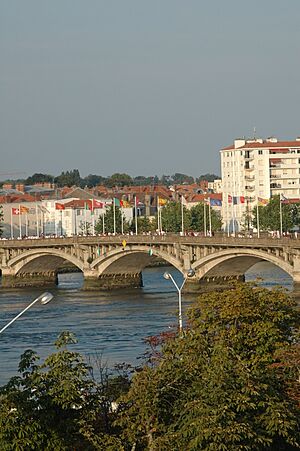
Many bridges cross the Nive and Adour rivers, connecting different parts of Bayonne.
- Over the Adour: The Saint-Esprit bridge is a famous one. It connects the Saint-Esprit district to the main city. It was rebuilt in stone in 1845.
- Over the Nive: The Pannecau bridge is another important one. It was once called the Bertaco bridge. A old rule said that a quarrelsome woman could be put in an iron cage and lowered into the Nive from this bridge! This punishment was called cubainhade and lasted until 1780.
Cycling
Bayonne is part of the Vélodyssée, a long cycling path. There are also bike paths along the rivers and in the city. You can even borrow bicycles for free in Bayonne!
Public Transport
- Buses: The Chronoplus bus network connects Bayonne to nearby towns like Anglet and Biarritz. There are also free shuttle buses that go around the city center.
- Coaches: Long-distance coaches connect Bayonne to other cities in the region.
- Trains: The Gare de Bayonne (Bayonne Train Station) is a busy station. You can catch high-speed trains (TGV) and regional trains here.
- Airport: Bayonne is served by the Biarritz – Anglet – Bayonne Airport. It's located nearby in Anglet and Biarritz.
People and Schools
Population
In 2017, Bayonne had 51,228 people living there.
| Historical population | |||||||||||||||||||||||||||||||||||||||||||||||||||||||||||||||||||||||||||||||||||||||||||||||||||||||||||||||||||
|---|---|---|---|---|---|---|---|---|---|---|---|---|---|---|---|---|---|---|---|---|---|---|---|---|---|---|---|---|---|---|---|---|---|---|---|---|---|---|---|---|---|---|---|---|---|---|---|---|---|---|---|---|---|---|---|---|---|---|---|---|---|---|---|---|---|---|---|---|---|---|---|---|---|---|---|---|---|---|---|---|---|---|---|---|---|---|---|---|---|---|---|---|---|---|---|---|---|---|---|---|---|---|---|---|---|---|---|---|---|---|---|---|---|---|---|
|
|
||||||||||||||||||||||||||||||||||||||||||||||||||||||||||||||||||||||||||||||||||||||||||||||||||||||||||||||||||
| Source: EHESS and INSEE | |||||||||||||||||||||||||||||||||||||||||||||||||||||||||||||||||||||||||||||||||||||||||||||||||||||||||||||||||||
Education
Bayonne has many schools for all ages.
- Kindergartens and Elementary Schools: There are 10 kindergartens and 22 elementary schools. Some are public, and some are private.
- Middle Schools: Bayonne has 2 public middle schools and 5 private ones.
- High Schools: There are 3 public high schools and 4 private high schools. These offer general, technology, and vocational education.
- Arts and Music: Bayonne also has a conservatory for music, dance, and dramatic art. There is also an art school.
Culture and Fun
Festivals and Events
- Ham Festival: For over 550 years, Bayonne has held a "Ham Festival" every spring.
- Fêtes de Bayonne: This is a huge annual summer festival. It lasts for five days and includes parades, bull races, fireworks, and music. It's one of the biggest festivals in France!
- Bullfighting: Bayonne has a long history of bullfighting. The current bullring opened in 1893. It's the largest in Southwest France, with over 10,000 seats. Bullfights are held every year, attracting famous bullfighters.
Sports in Bayonne
- Rowing: Rowing is a popular sport on the Nive and Adour rivers. There are two clubs, including Aviron Bayonnais.
- Basketball: The Denek Bat Bayonne Urcuit basketball club plays in Bayonne.
- Football (Soccer): Aviron Bayonnais FC is the main football club. They play their home games at Didier Deschamps Stadium. Didier Deschamps, a famous World Cup-winning footballer and coach, started his career here.
- Many Sports: Aviron Bayonnais is a large sports club with many different sections. The Bayonne Olympic Club also offers many sports like pelote, gymnastics, and combat sports.
- Basque Pelota: Bayonne is a very important place for Basque pelota. The French Federation of Basque Pelota is located here. Many champions have come from Bayonne.
- Rugby: Rugby became popular in the late 1800s. Aviron Bayonnais is a professional rugby club. They have won three French league titles. Their stadium is the Stade Jean Dauger. There is also a women's rugby team.
Places of Worship
Christian Faith
Bayonne is home to the Diocese of Bayonne. The main church is Bayonne Cathedral in Grand Bayonne. It is a beautiful Gothic-style building. There are also other churches like Saint-Esprit and Saint Andrew.
The Way of Baztan is a path for pilgrims going to Camino de Santiago. It passes through Bayonne.
Jewish Faith
The synagogue in Bayonne was built in 1837. The Jewish community in Bayonne is very old. It was formed by Jewish people who fled Spain and Portugal in the late 1400s.
Bayonne's Economy
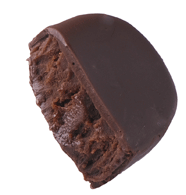
Bayonne is the economic center for its area. Most of its jobs are in services like trade, transport, and public administration.
Local Products
Bayonne is famous for its delicious foods:
- Chocolate: Bayonne has been making fine chocolates for 500 years.
- Bayonne Ham: This is a special cured ham seasoned with peppers from nearby Espelette.
- Izarra: This is a local liqueur made in bright green or yellow colors. You can visit the distillery.
- Mayonnaise: Some people say that mayonnaise was invented in Bayonne! It might have come from the word Bayonnaise, meaning "from Bayonne."
Bayonne also has special craft industries. These include making makilas, which are traditional Basque walking sticks. Another craft is making palas, bats used in pelota.
The Port of Bayonne
The port of Bayonne is at the mouth of the Adour River. It's a very busy port. It ships oil and sulfur from the nearby Lacq gas field. It's also the largest French port for exporting maize (corn). The port handles over 4 million tons of goods each year. It also receives cars from Spain and Portugal.
Tourism
Bayonne is a popular place for tourists. It's close to the ocean and the Pyrenees mountains. It also has a rich history. In 2012, the city had 15 hotels with over 800 rooms for visitors.
What to See in Bayonne
The Nive River divides Bayonne into two main parts: Grand Bayonne and Petit Bayonne. Five bridges connect them. Both areas are still protected by old walls built by Vauban. The houses along the Nive are in the traditional Basque style, with red and green colors. The wider Adour River is to the north.
- Cathédrale Sainte-Marie: This is a beautiful Gothic-style church. It was built between the 13th and 15th centuries. The cathedral is a UNESCO World Heritage Site.
- Château Vieux: This old castle dates back to the 12th century. It was where the city's governors lived, including the English Black Prince.
- Musée Basque: This museum teaches you about the entire Basque Country. It has exhibits on Basque farming, history, sailing, pelota, and crafts.
- Musée Bonnat: This art museum has a great collection of paintings. It includes works by famous artists like Edgar Degas and Francisco Goya.
- Château Neuf: Located in Petit Bayonne, this castle was started by the French in 1460. It's now an exhibition space.
- Ramparts and Botanic Gardens: You can walk along parts of the old city walls. Bayonne's botanic gardens are next to the walls.
- Saint-Esprit Church: This church was part of a larger complex built to help pilgrims traveling to Santiago de Compostela. It has a wooden sculpture called Flight into Egypt.
- Vauban's Citadelle: This large fort was built by Vauban in 1680. It overlooks the Saint-Esprit district. Soldiers who died attacking the citadel in 1813 are buried in the nearby English Cemetery.
- Izarra Distillery: You can visit the distillery where the famous local liqueur Izarra is made.
Famous People from Bayonne
Many interesting people were born in or lived in Bayonne:
- Edmund Crouchback (1245–1296): An English prince, son of King Henry III.
- Jean du Vergier de Hauranne (1581–1643): A theologian who brought a religious movement called Jansenism to France.
- Guillaume du Tillot (1711–1774): A politician.
- Marguerite Brunet (1730–1820): An actress and theater director.
- Dominique Joseph Garat (1749–1833): A writer and politician.
- Jacques Laffitte (1767–1844): A banker and politician.
- Frédéric Bastiat (1801–1850): A famous writer and economist.
- Charles Lavigerie (1825–1892): A Cardinal who founded the Society of Missionaries of Africa.
- Léon Bonnat (1833–1922): A well-known painter.
- René Cassin (1887–1976): A lawyer and judge who won the Nobel Peace Prize in 1968.
- Michel Camdessus (born 1933): The managing director of the International Monetary Fund for several years.
- Maurice André (1933–2012): A very talented classical trumpet player.
- Didier Deschamps (born 1968): A World-Cup-winning footballer. He is now the manager of the France national team.
- Sylvain Luc (1965–2024): A jazz guitarist.
- Xavier de le Rue (born 1979): A professional snowboarder.
- Imanol Harinordoquy (born 1980): A French international rugby union player.
- Aymeric Laporte (born 1994): A footballer who grew up in Bayonne.
Images for kids
See also
 In Spanish: Bayona (Francia) para niños
In Spanish: Bayona (Francia) para niños






